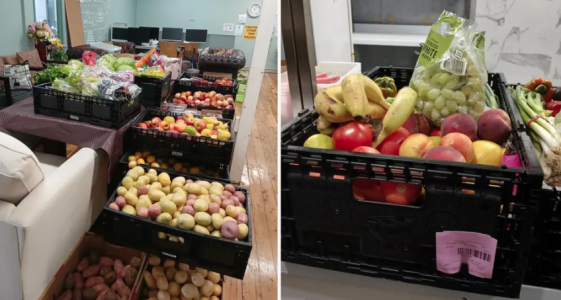Here's how Aussies can score incredible grocery haul for just $10
By
VanessaC
- Replies 8
At a time when grocery bills have become a source of stress for many Australians, finding ways to stretch the dollar without compromising on nutrition has become more important than ever.
As the prices of basic grocery items climb at major supermarkets like Coles and Woolworths, accusations of price gouging have surfaced, leaving many Australians feeling the pinch and seeking out more affordable alternatives.
The situation has become so dire that an increasing number of Aussies are turning to food banks for assistance.
Community Support Services in Sydney, for instance, has witnessed a dramatic rise in the number of people relying on their services.
Melisa Hake from the organisation, which is nestled in the heart of Bankstown in Sydney's Southwest, has seen firsthand the growing need for support among the community.
Founded six years ago, the organisation offers a lifeline to those struggling to afford fresh produce.
For just $10, individuals can order and collect a box brimming with a variety of fresh fruits and vegetables.
'We also have a community pantry shop where we sell cheaper groceries, including meat [and other essentials],' Hake said.
This incredible deal is made possible through the generous contributions of OzHarvest and SecondBite, two leading food charities in Australia. The community pantry shop run by the organisation also provides access to more affordable groceries, including meat and other essentials.
On a typical busy day, Hake noted that they sell around 10-12 hampers, with a clientele that includes refugees, students, families, and even the homeless.
'We generally have the same people that come,' she added.
'But the hampers are available to anyone. They just need to call up and order.'
The diversity of their clients has expanded, reflecting the broader impact of the current economic climate on various segments of the population.
The frustration among Australians over the rising cost of living is palpable, with many taking to social media to express their outrage.
The story of one shopper, Nat, who spent $46 on ingredients for a single meal, is a stark example of the financial strain many are experiencing.
Foodbank, a key player in the fight against hunger in Australia, reported that 3.7 million Australian households have faced moderate to severe food insecurity in the past year.
This means that a significant portion of the population is compromising on the quality, variety, or desirability of their food to save money.
Alarmingly, 77 per cent of these households are experiencing food insecurity for the first time, and at least 60 per cent households experiencing food insecurity have at least one member in paid work.
Brianna Casey, CEO of Foodbank Australia, has observed a significant shift in the demographics of those seeking food relief.
'We are seeing food insecurity touching groups previously unaffected including young professionals and mid to high-income earners are among those being forced to make sacrifices at the dinner table,' she said.
'Last week, we revealed Foodbank Australia sourced a record 51 million kilograms of food and groceries in 2023, the equivalent of 92 million meals, as the cost-of-living crisis pushed demand for food relief to record highs across the country.'
The Salvation Army has also noted an increase in first-time visitors to their support services.
Lauren Martin, a Mission Leader from the organization, spoke of the embarrassment and hesitation felt by those who are unsure if they should seek help, as they believed others may be in greater need.
Yet, the reality is that more people are living paycheck to paycheck and running out of money faster than before.
The Australian Council of Social Services (ACOSS) highlighted that people across the country are being forced to ration food to afford other essential items.
This is a clear indication that the cost-of-living crisis has heavily impacted the everyday lives of Australians.
 What are your thoughts on this story? Do you have tips on how to save on grocery bills? Share them with us in the comments below.
What are your thoughts on this story? Do you have tips on how to save on grocery bills? Share them with us in the comments below.
As the prices of basic grocery items climb at major supermarkets like Coles and Woolworths, accusations of price gouging have surfaced, leaving many Australians feeling the pinch and seeking out more affordable alternatives.
The situation has become so dire that an increasing number of Aussies are turning to food banks for assistance.
Community Support Services in Sydney, for instance, has witnessed a dramatic rise in the number of people relying on their services.
Melisa Hake from the organisation, which is nestled in the heart of Bankstown in Sydney's Southwest, has seen firsthand the growing need for support among the community.
Founded six years ago, the organisation offers a lifeline to those struggling to afford fresh produce.
For just $10, individuals can order and collect a box brimming with a variety of fresh fruits and vegetables.
'We also have a community pantry shop where we sell cheaper groceries, including meat [and other essentials],' Hake said.
This incredible deal is made possible through the generous contributions of OzHarvest and SecondBite, two leading food charities in Australia. The community pantry shop run by the organisation also provides access to more affordable groceries, including meat and other essentials.
On a typical busy day, Hake noted that they sell around 10-12 hampers, with a clientele that includes refugees, students, families, and even the homeless.
'We generally have the same people that come,' she added.
'But the hampers are available to anyone. They just need to call up and order.'
The diversity of their clients has expanded, reflecting the broader impact of the current economic climate on various segments of the population.
The frustration among Australians over the rising cost of living is palpable, with many taking to social media to express their outrage.
The story of one shopper, Nat, who spent $46 on ingredients for a single meal, is a stark example of the financial strain many are experiencing.
Foodbank, a key player in the fight against hunger in Australia, reported that 3.7 million Australian households have faced moderate to severe food insecurity in the past year.
This means that a significant portion of the population is compromising on the quality, variety, or desirability of their food to save money.
Alarmingly, 77 per cent of these households are experiencing food insecurity for the first time, and at least 60 per cent households experiencing food insecurity have at least one member in paid work.
Brianna Casey, CEO of Foodbank Australia, has observed a significant shift in the demographics of those seeking food relief.
'We are seeing food insecurity touching groups previously unaffected including young professionals and mid to high-income earners are among those being forced to make sacrifices at the dinner table,' she said.
'Last week, we revealed Foodbank Australia sourced a record 51 million kilograms of food and groceries in 2023, the equivalent of 92 million meals, as the cost-of-living crisis pushed demand for food relief to record highs across the country.'
The Salvation Army has also noted an increase in first-time visitors to their support services.
Lauren Martin, a Mission Leader from the organization, spoke of the embarrassment and hesitation felt by those who are unsure if they should seek help, as they believed others may be in greater need.
Yet, the reality is that more people are living paycheck to paycheck and running out of money faster than before.
The Australian Council of Social Services (ACOSS) highlighted that people across the country are being forced to ration food to afford other essential items.
This is a clear indication that the cost-of-living crisis has heavily impacted the everyday lives of Australians.
Key Takeaways
- The rising cost of groceries in Australia has led more people to rely on food banks and cheaper alternatives.
- Community Support Services in Sydney that offers $10 fresh fruit and vegetable boxes saw an increase in Aussies using the service.
- Food insecurity has affected a broader range of Australians, including those previously unaffected.
- Foodbank Australia has sourced a record amount of food as demand for food relief reaches new highs due to the cost-of-living crisis.








